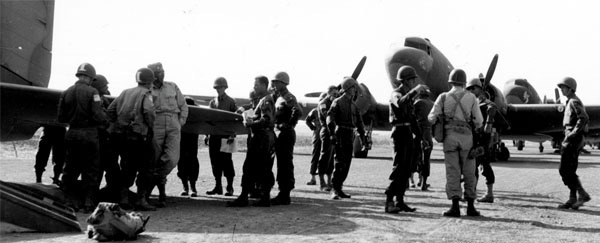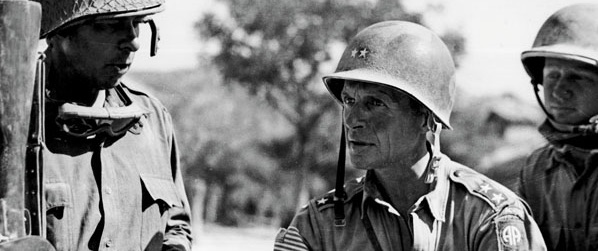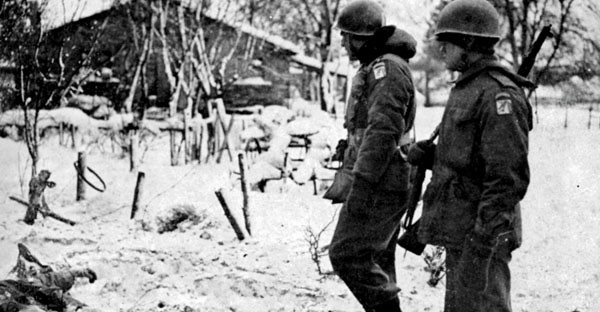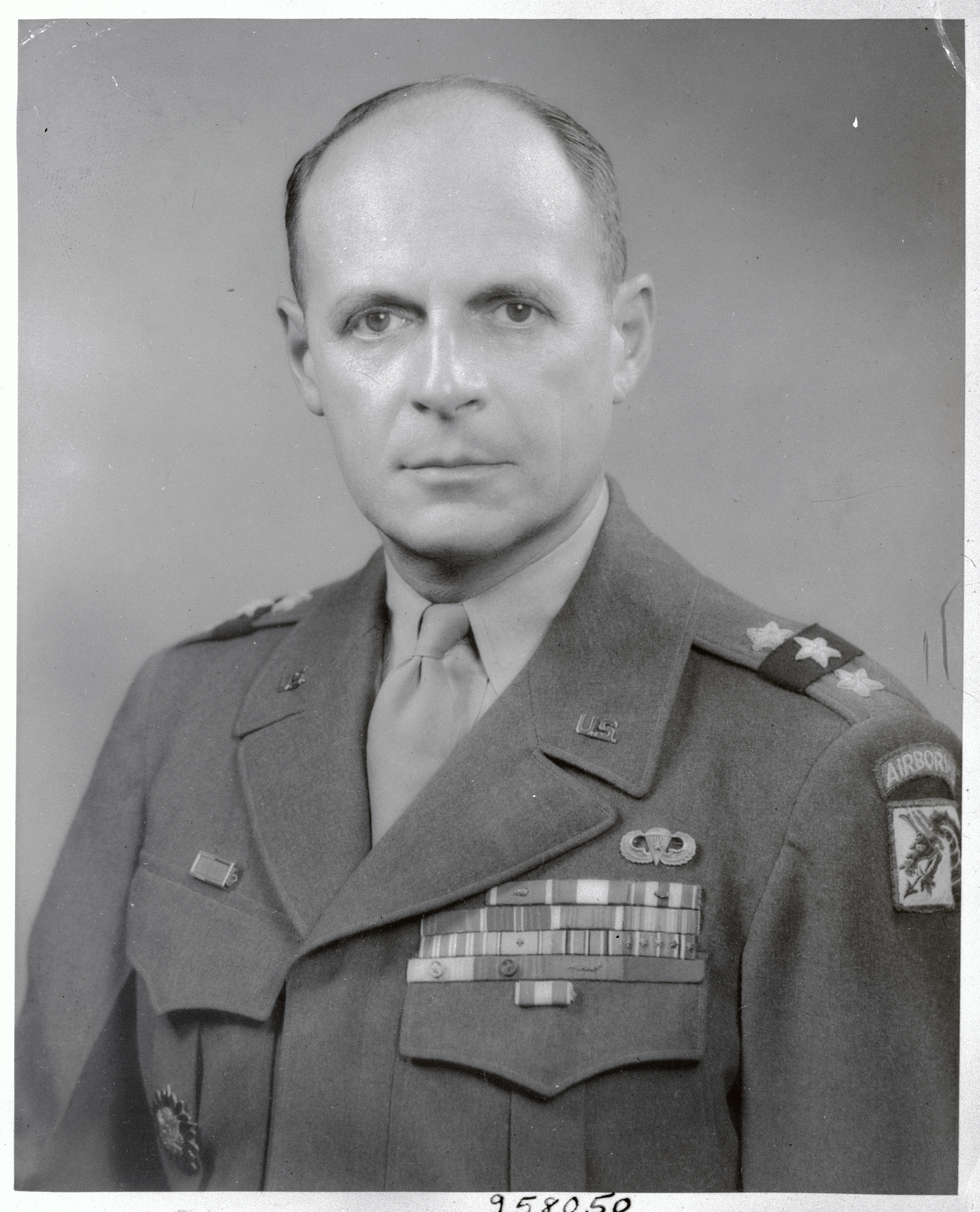Acts of great courage in war aren’t limited to the battlefield. One little-known incident during World War II defined Major General Matthew B. Ridgway as a commander of unrivaled courage when he laid his career on the line at a critical moment.
On September 3, 1943, the Allies signed a secret armistice with Italy that would take the Axis power out of the war just a few hours before the invasion of Salerno on September 9. Around the same time, a plan was being hatched in partnership with Italy for the Allies to capture Rome. Code-named Giant II, the plan called for Italian troops to support an American airborne operation to seize and hold the city. The plan had the enthusiastic support of the Allied high command—particularly General Dwight D. Eisenhower’s chief of staff, Lieutenant General Walter Bedell Smith, who sold both Eisenhower and the Allied ground commander in chief, British General Harold R. L. G. Alexander, on its merits.
The plan was to drop 82nd Airborne Division paratroopers and glider troops at airfields 25 miles northwest of Rome on September 8. These forces would link up with approximately four divisions of Italian troops and seize Rome in a single swift attack. An enthusiastic Roman citizenry would assist, General Smith assured planners, by dropping “kettles, bricks, and hot water on the Germans in the streets.” The operation was to coincide with the landings at Salerno the following day; its architects believed these two developments would compel German forces defending central and southern Italy to withdraw to the Apennine Mountains to the north.
On paper Giant II seemed a brilliant masterstroke; in practice it would have been a recipe for disaster.
From the outset, Ridgway believed there was insufficient time to properly plan the Rome operation, which he saw as a risky, harebrained idea that would destroy his division. Though Ridgway had no luck persuading his superiors of Giant II’s shortcomings, he refused to commit his division until he had taken his concerns directly to General Alexander. Alexander, however, declined to cancel Giant II and assured Ridgway that within five days Allied ground troops would fight their way to Rome to reinforce the 82nd Airborne.
Ridgway persisted. His perseverance paid off when the division artillery commander, Brigadier General Maxwell Taylor, and another officer assessed the situation firsthand. They undertook a dangerous secret mission to Rome, arriving at dusk on September 7. Taylor soon discovered that the claims made in support of Giant II were absurd. Not only were the Italians unwilling to guarantee the security of the airfields on which the 82nd would land, but the entire situation bore scant relation to its backers’ claims. The Italians, fearful of German retaliation, had backed out of their commitment to support the operation.
Far more ominous, Taylor learned, was that the planners had relied on faulty intelligence. They thought the Germans had only two battalions of combat troops near Rome able to intervene against an Allied raid. Instead, Taylor learned of the presence there of two battle-tested Panzergrenadier divisions—including the 24,000 men and 150 heavy and light tanks of the 3rd Panzergrenadier Division. These troops would not be deterred by an airborne force inferior in numbers and lacking heavy weapons or air support. Moreover, the Allies only had enough planes initially to move the equivalent of a reinforced regiment, roughly 3,000 men, to Rome—in a night drop that would take them over a German-occupied area rich with antiaircraft guns.
Early on the morning of September 8, Taylor urgently radioed Eisenhower’s Allied Force Headquarters in North Africa to declare that Giant II was impossible and had to be cancelled. The 82nd, meanwhile, continued staging in Sicily for the drop. By late that afternoon their orders still held, and the crews of 62 aircraft, engines running and loaded with the paratroopers of Colonel Reuben Tucker’s 504th Parachute Infantry Regiment, were waiting on several airfields for final instructions. At literally the last moment, word came from North Africa that the “Rome job” was postponed. The division’s chief administrative officer (G-1), Colonel Ralph P. “Doc” Eaton, had to dash onto one airfield to stop pathfinders about to take off.
That night, Giant II was cancelled altogether, averting the almost certain capture or annihilation of a major element of the 82nd Airborne.
In the immediate aftermath, which historian Clay Blair recounted in his book Ridgway’s Paratroopers: The American Airborne in World War II, Doc Eaton returned to his tent “thinking that if Ridgway hadn’t fought that thing tooth and nail we’d have gone in and it would have been a disaster.” When Ridgway arrived with a bottle of whiskey, each man had a drink. Then Ridgway, one of the toughest soldiers ever produced by the U.S. Army, began to cry. So did Eaton. “It was so close and we felt so deeply about it and we were both exhausted,” Eaton recalled. After Ridgway left, he said, “I sat there thinking that I owed him my life.” For daring to oppose this operation, Ridgway and Taylor became the targets of unofficial censure by Walter Bedell Smith and others of the Allied Force Headquarters staff. But Ridgway had no regrets: he knew he had saved his division. It took eight more months before General Alexander’s misguided prediction of Allied ground troops arriving in Rome was realized; the Allies finally liberated the city in early June 1944.
“When the time comes that I must meet my Maker, the source of most humble pride to me will not be accomplishments in battle, but the fact that I was guided to make the decision to oppose this thing,” Ridgway wrote in his memoirs. “I deeply and sincerely believe that by taking the stand I took we saved the lives of thousands of brave men.”

Matthew Bunker Ridgway, the son of a career army officer, was born at Fort Monroe, Virginia, on March 3, 1895. Raised on posts from Walla Walla, Washington, to Fort Snelling, Minnesota, and Boston, Massachusetts, he would recall that his earliest memories were “of guns and marching men, of rising to the sound of the reveille gun and lying down to sleep at night while the sweet, sad notes of ‘Taps’ brought the day officially to an end.”
The young Ridgway initially had no thought of emulating his father. But by the time he graduated from Boston’s English High School in 1912 he had changed his mind and sought an appointment to West Point—only to fail the geometry portion of the entrance exam and spend a year cramming to retake the test. He was successful the second time, and entered the United States Military Academy in June 1913.
Ridgway’s years at West Point were unremarkable, but—like Eisenhower, who severely injured a knee doing dangerous drills on horseback—Ridgway nearly ended his military career before he could be commissioned, when he hurt his back in a fall from a horse. He managed to graduate with the class of 1917, but throughout his military service the injury would periodically plague him. One spasm struck in June 1944, five hours before he was to jump into Normandy on the eve of D-Day. Another occurred shortly before the March 1945 airborne assault across the Rhine.
Ridgway was commissioned in the infantry and first served on the Mexican border. When the United States entered World War I, he was anxious for combat duty in France but instead spent the war as an instructor at West Point, expecting his career to suffer as a result. He went on to command infantry companies in China and Nicaragua, where he helped supervise elections (and contracted malaria), and served as advisor to the Governor-General of the Philippines.
By the start of World War II, Ridgway, by then a full colonel in the War Plans Division of the War Department, was chafing for troop duty. His chance came in late January 1942, when army chief of staff General George C. Marshall promoted Ridgway to brigadier general and named him second in command of the newly reactivated 82nd Division. The unit had gained fame during World War I for spending more consecutive days at the front than any other American division. In August 1942 the 82nd was converted into the first airborne division in the U.S. Army, with Ridgway, now a major general, in command. It was a difficult challenge, but Ridgway, 47, earned his paratrooper wings and guided the 82nd through a successful transition to a combat-ready parachute unit.
In April 1943, the 82nd deployed to North Africa to participate in the invasion of Sicily, set for July. It was the army’s first large-scale parachute drop. But problems arose right from the start. The first night, the drop of Colonel James M. Gavin’s 505th Parachute Infantry Regiment went badly awry when winds scattered the paratroopers over a 60-mile swath of southern Sicily. The next night, nervous Allied gunners mistakenly fired on the C-47s carrying the 504th Parachute Infantry Regiment, killing 81 paratroopers and wounding 132 others.
These debacles could have sounded a death knell for airborne units. During the investigation that followed, Ridgway fought to keep the army from renouncing airborne’s potential and disbanding the paratroop divisions. He used the inquiries to highlight instances in Sicily in which airborne troops turned errors into advantages, successfully fighting in small groups and even alone, always focused on the mission.
Ridgway’s division soon had an opportunity to allay any lingering misgivings on the parts of Eisenhower and other senior commanders. Shortly after Giant II was cancelled, Fifth Army commander Lieutenant General Mark W. Clark called on the 82nd to help save the beleaguered Salerno beachhead. On September 13, 1943, with the Germans resisting tenaciously and the situation increasingly desperate, Clark sent Ridgway an urgent letter ordering the 82nd to drop into the beachhead that very night. With mere hours to go, Ridgway’s reply was a simple “can do.”
That night the 1,300 men of Colonel Tucker’s 504th loaded onto troop carrier aircraft “by the light of a few flashlights and maps held against the side of a plane,” as one observer noted. In one of the war’s most dramatic operations, the 504th parachuted into the beachhead at Paestum; a similarly successful drop of Gavin’s 505th followed the next night. The two regiments of tough paratroopers became a fire brigade that helped save the Salerno beachhead from annihilation and changed the course of the fledgling Italian Campaign.

Throughout his career, Matthew Ridgway earned a reputation as one of the army’s most compelling and demanding battlefield commanders, an officer who exemplified the meaning of leadership. His intolerance for inefficiency, mediocrity, and incompetence was legendary. He picked the best men to command his units, and expected and got nothing but the best from officers like Jim Gavin, Maxwell Taylor, Benjamin Vandervoort, and Reuben Tucker.
Those who did not measure up were soon replaced. In return, Ridgway gave his men great loyalty and confidence—a sense that they could accomplish anything they set out to do, that whatever hardships they encountered were mere bumps in the road to victory.
Early on, he gained the complete trust of the men of the 82nd Airborne. Their professionalism was a direct reflection of their commander, and the bond he formed with his men was the key to his success. Soldiers are never duped by an insincere or phony leader, and in Ridgway GIs recognized they had an outstanding commander who never lacked compassion and did the little things to get their attention and raise their morale (see “What Was With Those Grenades?” at left). Ridgway was reputed to have known the names of several thousand of his men, and it had a powerful effect when he addressed them personally. “There was no way General Ridgway could be a better division commander,” one of his company commanders said. “He was most respected but not feared. He never talked down to us…, used a profane or vulgar word…. He could be ruthless but never cruel. His knowledge of infantry weapons was phenomenal…. He gained the respect of my people by pointing out our mistakes in a gentlemanly but firm manner.”
Ridgway possessed another essential trait of a great leader: character, which he once said “is the bedrock on which the whole edifice of leadership exists.” A corps commander thus paid him a high compliment following a particularly critical phase of the Battle of the Bulge, where Ridgway commanded an airborne corps. “I’m glad to have you on my flank,” the officer told Ridgway. “It’s character that counts.”
Ridgway explained his own views on leadership this way: “To my mind, the highest service a man can perform is lead other men into battle. It requires of him courage and competence of the highest order,” and “a complete willingness to sacrifice his own life for them, if need be.”
Ridgway’s toughness was on full display during the buildup to the invasion of Normandy in June 1944. He suffered a recurrence of malaria and reinjured his back in a fall, but still managed to work 14-hour days and make two practice jumps.
When Ridgway parachuted safely onto a grassy field near the Merderet River early on D-Day, he quickly realized that his troops had landed far from their drop zones and were spread over a wide area. They would have to fight on their own until relief came after the amphibious landings on Utah Beach. With communications virtually nonexistent, Ridgway could only influence the actions of his paratroops by example.
When heavy fire from German 88s hit his command post the next day, everyone ducked except Ridgway, who stood bareheaded, oblivious to the peril he was in. Not long afterward he arrived at a farmhouse sheltering wounded paratroopers, including one on a stretcher who exclaimed, “Still sticking your neck out, huh, General?”
Such leadership was infectious. In the early hours of the battle a crucial fight erupted at the La Frière causeway and bridge, where enemy mortar and artillery fire were intense. As men dove for cover, Ridgway and his recently promoted assistant division commander, Brigadier General James Gavin, stood and calmly led their men into battle. While shells fell all around him, Ridgway rigged a towing cable on a disabled tank that was blocking the way.
“Few American generals of World War II would experience such a hellish nightmare,” historian Clay Blair later wrote. “And yet, Ridgway, according to many who were present, did not once falter, did not yield to pessimism, doubt or fear.” For his valor GIs gave him the admiring nickname Causeway Kid.
When Ridgway was appointed to command the XVIII Airborne Corps in September 1944, he had a hard time letting go of his beloved 82nd Airborne, whose command went to Jim Gavin. The corps’s two divisions, the 82nd and 101st, played major roles that month in Operation Market Garden—notorious as one of the great Allied failures of the war—but Ridgway’s part was largely reduced to spectator. The Allied high command undoubtedly erred when it failed to appoint Ridgway to plan and carry out the airborne phase of the operation to seize a bridgehead over the Rhine. Instead, the command went to British Lieutenant General Frederick “Boy” Browning, who ignored critical intelligence and failed to address glaring flaws in the airborne plan. The far more experienced and forceful Ridgway—who referred to the command supervision as a “monument to human weakness, to the failure to strike hard and boldly”—no doubt would have exposed those flaws and, as he had with the aborted drop on Rome, laid his career on the line to ensure the operation had a solid foundation.
Ridgway’s opportunity to lead the XVIII Airborne into combat came on December 16, 1944, with the commencement of the great German counteroffensive known as the Battle of the Bulge. The 82nd and 101st Divisions were hastily deployed to help defend American positions in the Ardennes.
At his command post near the front, Ridgway seemed at his cool and methodical best. “The more dire the threat, the calmer he appeared to be,” Blair wrote. “In the Bulge, he would become a rock to which many senior commanders would cling.” Despite the increasingly grave situation as the German attacks gained momentum, Ridgway remained fearlessly on the move—walking, riding, sometimes even crawling through the snow at or near the thick of the fighting to orchestrate defenses and counterattacks and again lead by example. It was not unusual for a GI in a frontline foxhole to suddenly find his corps commander next to him.
Officers who Ridgway perceived as weak or wilting under pressure were relieved on the spot. This included two division commanders in the Ardennes, one of whom Ridgway knew from their cadet days at West Point. “It is an appalling thing to witness—to see a man break completely like that, in battle,” Ridgway later remarked. “It is worse than watching a death—for you are seeing something more important than the body die. You are witnessing the death of a man’s spirit, of his pride, of all that gives meaning and purpose to life.”
When the gallant but decimated 7th Armored Division that had held the vital crossroads town of St. Vith for nearly a week could hold on no longer, Ridgway orchestrated the unit’s successful withdrawal. “We brought them out without the loss of a man, with all their equipment,” he recalled. “In fact, we hauled out with us several 8-inch howitzers which had been abandoned by units not then present in the encircled area.”
After the war, Gavin referred to Ridgway’s frontline leadership by saying, “He was a great combat commander…. Hard as flint and full of intensity; so much so, I thought, ‘That man’s going to have a heart attack before it’s over.’ Sometimes it seemed as though it was a personal thing: Ridgway versus the Wehrmacht.”

Ridgway went on to command the Eighth Army and United Nations forces in Korea after World War II. He also served as the military governor of Japan, NATO supreme allied commander, and the U.S. Army chief of staff. Few officers have held more challenging positions than Ridgway, who retired in 1955 after 38 years of service. And few have received higher praise than that from General George C. Marshall, who called Ridgway “the finest soldier I have known.”
Among his decorations were two Distinguished Service Crosses, two Silver Stars, a Purple Heart, four Distinguished Service Medals, and a Bronze Star. In 1986, President Ronald Reagan awarded Ridgway the Presidential Medal of Freedom, saying, “Heroes come when they’re needed; great men step forward when courage seems in short supply. World War II was such a time. And there was Ridgway.”
Matthew Ridgway died in 1993 at the age of 98, and is buried at Arlington National Cemetery. “No soldier ever performed his duty better than this man,” said General Colin Powell, then the chairman of the Joint Chiefs of Staff, in a graveside eulogy. “No soldier ever upheld his honor better than this man did…. Every American soldier owes a debt to this great man.” It was the passing of an era: Ridgway was the last of the American generals famed for their World War II leadership, and men whose lives he helped save survived to mourn him.





